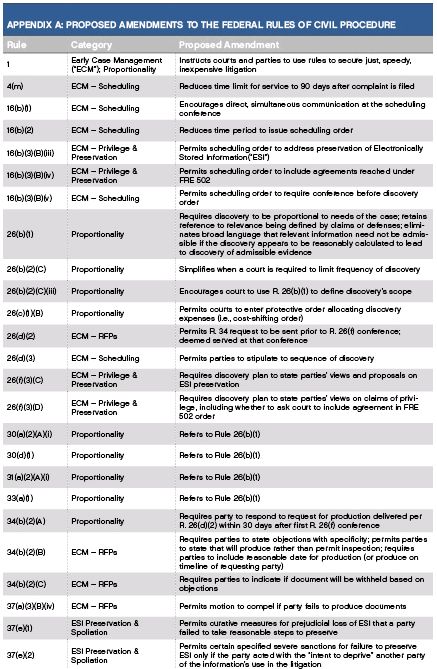On April 29, 2015, the U.S. Supreme Court approved and submitted to Congress proposed amendments to the Federal Rules of Civil Procedure ("FRCP" or "Rules") ("April 2015 Rules").1 The April 2015 Rules will take effect on December 1, 2015, unless Congress enacts legislation to reject, modify, or defer the rules. Any such action is highly unlikely. The amendments, which arguably entail the most significant alterations to the discovery rules in more than two decades, will "govern in all proceedings in civil cases thereafter commenced and, insofar as just and practicable, all proceedings then pending."2 The April 2015 Rules amend Rules 1, 4, 16, 26, 30, 31, 33, 34, 37, and 55, and abrogate Rule 84 and the Appendix of Forms.3
In March 2014, Jones Day published a White Paper titled "Proposed Changes to the Federal Rules of Civil Procedure," which addressed the proposed Rules amendments published for public comment in August 2013 ("August 2013 Rules").4 At that time, the Judicial Conference's Rules Committee (the "Committee") received over 2,300 comments and held three public hearings where more than 120 witnesses provided testimony. 5 Since that White Paper, the Committee revised the proposed amendments, and the Standing Committee unanimously approved the April 2015 Rules on May 29, 2014. On April 29, 2015, the U.S. Supreme Court also approved the amendments in their entirety and submitted them to Congress for final approval.6
This White Paper provides an overview of the proposed amendments, including how the amendments evolved between August 2013 and April 2015, and discusses the practical implications the April 2015 Rules will have on early case management, discovery, and litigation strategy.
OVERVIEW OF THE PROPOSED APRIL 2015 RULES
In an effort to achieve the overarching goal of the FRCP "to secure the just, speedy, and inexpensive determination of every action and proceeding,"7 at a high level the amendments submitted to Congress in April 2015 address early case management and the overall scope of discovery.
The changes to early case management expedite the initial stages of litigation. The amendments that impact the scope of discovery emphasize proportionality and reasonableness and force more specificity in responding and objecting to document requests, including identifying the basis on which documents are being withheld and when a party anticipates completing production. In many respects, the discovery amendments conform the Rules to the current best practices of many courts and parties.
The amendments also for the first time directly address preservation, aiming to resolve jurisdictional differences and standardize practices, specifically the sanctions for spoliation of electronically stored information ("ESI").
Significantly, the amended Rules are intended to help return the focus of discovery to its rightful place: the merits of the claims and defenses in the litigation. The amendments related to discovery focus almost entirely on document discovery, which is often the most burdensome and expensive part of the discovery process. If properly applied by the courts and leveraged by litigants, the April 2015 Rules should reduce document discovery burdens and costs.
EARLY CASE MANAGEMENT
Scheduling and Cooperation—Amendments to Rules 1, 4(m), 16(b), and 26(f)
Several amendments aim to reduce delay and improve cooperation in early case management. Rule 1 seeks to make it clear that the parties have an obligation to make litigation efficient, adding that the Rules "should be construed, administered, and employed by the court and the parties to secure the just, speedy, and inexpensive determination of every action and proceeding."8 Specifically, the Committee Note to Rule 1 states:
Rule 1 is amended to emphasize that just as the court should construe and administer these rules to secure the just, speedy, and inexpensive determination of every action, so the parties share the responsibility to employ the rules in the same way .... [D]iscussions of ways to improve the administration of civil justice regularly include pleas to discourage over-use, misuse, and abuse of procedural tools that increase cost and result in delay. Effective advocacy is consistent with—and indeed depends upon—cooperative and proportional use of procedure.9
The amendments to Rules 4(m), 16, and 26(f) seek to reduce delay in the early stages of litigation through more active judicial case management and reduced timelines in six distinct ways. First, Rule 4(m) reduces the presumptive time to serve a defendant from 120 to 90 days.10 The August 2013 Rules included a 60-day deadline to serve a defendant. The change to 90 days in the April 2015 Rules reflects a compromise between the Committee's desire to shorten the period and commentators' concerns that 60 days would be problematic in cases involving multiple defendants, defendants who are difficult to locate, or defendants who must be served by the U.S. Marshals Service.11
Second, the Committee Notes to Rule 16(b)(1) encourage that courts hold a scheduling conference that involves "direct simultaneous communication" between parties and that "may be held in person, by telephone, or by more sophisticated electronic means."12 Third, Rule 16(b)(2) reduces the time to issue a scheduling order to the earlier of 90 days (down from 120 days) after any defendant has been served, or 60 days (down from 90 days) after any defendant has appeared, unless the judge finds good cause for delay.13 Fourth, Rule 16(b)(3) permits the scheduling order to require a conference with the court before a party may move for a discovery order.14
Fifth, Rule 16(b)(3) adds that the scheduling order may provide for preservation of ESI and for any agreements the parties reached under Federal Rule of Evidence 502, which governs attorney-client privilege and work product.15 Finally, in accordance with Rule 16, Rule 26(f)(3) requires the parties' discovery plan to state the parties' views and proposals on issues about preservation of ESI and include court orders under Rule of Evidence 502.16
Practical Implications of These Amendments
The new language in Rule 1 (i.e., "and employed by the court and the parties") will impose a standard on all parties involved to construe the Rules as providing a means for the "just, speedy, and inexpensive determination of every action and proceeding." To adhere to Rule 1 and decrease litigation costs, parties should reduce "hyperadversary behavior."17 Parties should instead balance cooperation with legitimate or essential adversarial behavior—in other words, effective and efficient advocacy.
The reduced time for entry of a scheduling order and discovery conference will enable the parties to set the tone and expectations at the beginning of litigation with less delay and time-consuming posturing. Parties should consider whether they would like the scheduling order to require that parties request a conference with the court prior to filing discovery motions. If so, they should request that the court include it in the scheduling order. If not, they should be prepared to respond to such a request by the opposing party. Many courts have found that holding a brief discovery conference resolves issues with less time and expense because it helps the court and parties to identify and promptly address actual or potential disputes.
To make the most of the scheduling conference, a party should plan ahead, anticipate delays and disputes, and consider what deadlines will be practical in light of any constraints, such as client preferences or the location, format, and accessibility of documents to be preserved. Document preservation obligations, which can be extremely burdensome and costly, frequently arise prior to the commencement of the action and, in any event, are ongoing at the time of the scheduling conference. These amendments provide an opportunity to expedite the resolution of those burdens and costs.
In addition, parties can benefit from early planning regarding the scope of protection that will be provided to inadvertently produced privileged information, which can impact the cost-benefit analysis with respect to subsequent document discovery options. Teeing these issues up early, rather than leaving them to linger where one (or both) parties do not act affirmatively, can negate unnecessarily costly preservation and/or document review and avoid high-priced disputes down the road.
PROPORTIONALITY
Scope of Discovery—Amendments to Rule 26
The key change to Rule 26 replaces language that is often used to argue that the scope of discovery should be broad, including "reasonably calculated to lead to the discovery of admissible evidence," with the language "and proportional to the needs of the case."18 Rule 26(b)(1) now makes proportionality considerations part of the definition of the scope of discovery and reinforces parties' obligations to consider proportionality in making discovery requests, responses, and objections. It does so by elevating the proportionality factors previously found under Rule 26(b)(2)(C), albeit in a different order, and adding as a factor "the parties' relative access to relevant information."19 In addition, Rule 26(c)(1)(B) will authorize courts to issue cost-shifting orders, determining the "allocation of expenses" for certain discovery. 20
Practical Implications of These Amendments
These proportionality considerations are not new. As mentioned above, all but one of the factors appear in the current version of Rule 26(b)(2)(C), current Rule 26(g)(1)(B)(iii) also addresses them to some extent, and courts already consider proportionality in discovery, evaluating most of the factors incorporated in the proposed amendments.21 For example, courts appear more likely to limit discovery if the request at issue requires costly searching of back-up tapes or if the requesting party has already asked for and received a significant amount of discovery.22 Courts also closely evaluate requests to ensure they are appropriately limited in subject matter and time period.23 Additionally, courts have already been engaging in cost-shifting, which is now incorporated into the Rule.24 The amendments simply reinforce the fact that parties and courts must consider what is necessary for the case in light of related burdens.
The amendments also put responding parties in a better position to argue that discovery is not permitted where it does not satisfy the enumerated proportionality limitations. Historically, responding parties were in a quandary as to whether a motion for protection was necessary when objecting on proportionality grounds. Now, it is clear that a specific objection will preserve the position.
A number of practice points can be drawn from the existing treatment of proportionality and these amendments.
- To be in a position to fully leverage proportionality limitations, parties should consider whether the manner in which they list and describe claims and affirmative defenses may unnecessarily or unintentionally expand the scope of discovery.
- Parties should draft discovery requests with the proportionality limitations in mind and consider the costs associated with responding to the requests.
- Responding parties should quickly correct any assertion that the appropriate scope of discovery is that which is "reasonably calculated to lead to the discovery of admissible evidence." That position was never correct, a fact that should be all the more clear once the language is removed.
- Responding parties should consider the specific burdens and costs associated with specific requests as compared to the information the specific requests are likely to elicit and appropriate alternatives or limits to the requests as served. If the same information could be obtained in another form of discovery that would be less burdensome (e.g., interrogatories, depositions), the responding party should highlight as much for the serving party and the court.25
- Related to the new factor—"the parties' relative access to relevant information"—parties should consider where information asymmetry does and does not justify certain burdens.26
- In negotiating about the scope of its response, the responding party should be prepared to discuss specifics about the burdens and expenses they assert.
- Because courts are likely to seek compromises, parties should consider offering concessions to demonstrate their reasonableness if there is a dispute (e.g., a portion of the requested information, cost shifting).27
- Parties must take into consideration the now-confirmed right of a court to issue cost-shifting orders to allocate the expenses of discovery. The express grant of this authority in Rule 26(c)(1)(B) will reduce motion practice challenging a court's authority to enter such orders.
- Parties should appreciate that while there will certainly be discovery disputes based on the requirements of the amendments, the enhanced framework for proportionality should increase the predictability of discovery and streamline the resolution of those disputes.
- Finally, simply noting that the amount in controversy is large and the responding party's resources are substantial is not a sufficient proportionality analysis. Rather, the benefit of the information requested should be weighed against the costs.28 Conversely, a hefty price tag does not alone indicate "disproportionality."29 All proportionality factors must be considered.
Rejected Amendments to Rules 30, 31, 33, and 36
The April 2015 Rules withdrew controversial proposed amendments to Rules 30, 31, 33, and 36 that imposed numerical limits to encourage efficiency and cooperation through early case management.30 The August 2013 Rules had proposed reducing the presumptive limits on number of depositions (from 10 to five depositions per party); length of depositions (from seven to six hours each); number of interrogatories (from 25 to 15); and number of requests for admission (from no limit to 25).31 Public comments staunchly opposed these limits.32 Commentators feared that the proposed limits would become hard limits and deprive parties of evidence needed to prove their claims or defenses.33 The Committee withdrew the limits, concluding that the goals of proportionality and effective case management could be achieved through other rule changes. The Committee instead amended Rules 30, 31, and 33 to refer to Rule 26(b)(1) and incorporate its emphasis on proportionality.34
REQUESTS FOR PRODUCTION
More Specificity Required—Amendments to Rules 26(d), 34(b), and 37(a)
Amendments to three rules result in a number of changes to the timing of requests for production of documents ("RFPs") and substance and timing of responses to RFPs. Rule 26(d)(2) will now permit a party to serve RFPs prior to a Rule 26(f) conference, but no earlier than 21 days after the receiving party was served in the litigation. RFPs served prior to a Rule 26(f) conference will be deemed to have been served at the first Rule 26(f) conference.35 Rule 34(b)(2) requires responding parties to (i) be more specific in objections to RFPs; (ii) state whether documents actually will be withheld pursuant to each objection; (iii) state whether they will produce copies or permit inspection; and (iv) complete production "no later than the time for inspection specified in the request or another reasonable time specified in the response."36 In parallel and "to reflect the common practice of producing copies of documents or [ESI] rather than simply permitting inspection," Rule 37(a)(3)(B)(iv) permits a party to move for an order compelling production if another party fails to produce documents.37
Practical Implications of These Amendments
First, allowing early RFPs under Rule 26(d)(2) may facilitate more productive 26(f) conferences, which may streamline the discovery process. For example, a receiving party could highlight issues with the breadth of discovery requests at the 26(f) conference. That could make later-served objections and responses consistent with that discussion less problematic, or at least more understandable, to the party who served the RFPs. That said, some commentators doubt parties will serve RFPs prior to the 26(f) conference because doing so will give responding parties more time to formulate objections and arguments against production. Others worry that parties will serve broad requests to gain leverage at the 26(f) conference.38 Given these considerations, when determining whether to serve early RFPs, parties must balance the effectiveness of the 26(f) conference as an opportunity to substantively resolve issues against concerns regarding anticipated discovery disputes.
As for the changes to Rule 34(b), the amendments will likely require more front-end work by parties responding to RFPs, but may reduce costly disputes later in the process. Significantly, parties will need to be specific in their objections. For example, rather than asserting that a request is "unduly burdensome" without specifying how it is burdensome or what that burden means to the scope of production, the party will need to be more specific. For example, a party could object that a request is unduly burdensome because it calls for discovery from an unnecessarily broad range of custodians, and could assert that documents will be withheld from custodians and sources that are not identified by the responding party (or agreed upon in subsequent negotiations). Similarly, rather than asserting that a request is "vague" in specific or general objections, the responding party will need to explain why it is vague. For example, a party could object that a request for "documents about costs" is vague because it may be read to include research and development, manufacturing, raw materials, labor, and other overhead costs, many of which are irrelevant to the claims and defenses in the matter and/or do not warrant the associated expense. The party could assert that, as a result, it will only produce documents that relate to the cost of materials.39
The requirement to identify the format in which documents will be produced merely requires the responding party to be aware of the need to specify certain basic information (e.g., options for acceptable forms of production and pros and cons associated with each), to be thoughtful regarding the best means of producing the documents, and to factor in how the responding party would like to receive productions. Parties already often address these format issues at or before the required time and in greater detail than the amended Rule requires.40
Additionally, the requirement to specify a production deadline seeks to increase predictability and reduce discovery fights over the timeliness of productions. Unfortunately, discovery disputes regarding what constitutes a "reasonable time" for production are likely to ensue.41 Parties could try to address this requirement in several ways. First, parties may wish to incorporate "reasonable time" considerations into their scheduling orders. Second, while it may be difficult to determine the timing required to make productions prior to negotiating the scope of discovery, doing so may provide a basis to argue that the scope should be sufficiently narrow to allow a party to comply with the deadline.
ESI PRESERVATION
Uniform Standards—Amendments to Rule 37(e)
The amended Rule 37(e) provides broad discretion for courts to cure prejudice caused by loss of ESI and resolves a circuit split as to when courts may impose more severe sanctions for failures to preserve ESI.42 After significant discussion and revision, the proposed amendment to Rule 37(e) sets the stage in its first clause for when any curative measures or sanctions may be contemplated: "If [ESI] that should have been preserved in the anticipation or conduct of litigation is lost because a party failed to take reasonable steps to preserve it, and it cannot be restored or replaced through additional discovery ...."43 As the first step, therefore, a party moving for sanctions for failure to preserve ESI must show: (i) relevant ESI "should have been preserved in the anticipation or conduct of litigation"; (ii) relevant ESI was lost because the party charged with safeguarding the lost ESI "failed to take reasonable steps to preserve" the information; and (iii) the lost ESI "cannot be restored or replaced through additional discovery."44 If this predicate showing is made, then the court "(1) upon finding prejudice to another party from loss of the information, may order measures no greater than necessary to cure the prejudice; or (2) only upon finding that the party acted with the intent to deprive another party of the information's use in the litigation may ..." impose more severe sanctions enumerated in the Rule.45
The Committee made substantial changes to the August 2013 proposed amendments to Rule 37(e). The Committee limited the Rule—which originally applied to all types of discoverable information—to electronically stored information ("ESI"). The Committee decided to confine Rule 37(e) to ESI because "the law of spoliation for evidence other than ESI is well developed and longstanding, and should not be supplanted without good reason."46 The explosion of ESI in recent years presents unique and unprecedented challenges, leading the Committee to conclude that ESI merits special treatment.
Additionally, the April 2015 version expected to be adopted withdraws two changes in the August 2013 version: (i) a uniform "willful or bad faith" standard for sanctioning a litigant for spoliation; and (ii) five factors for courts to consider in assessing a party's conduct to determine a sanctions award for the loss of discoverable information.47 Public comments to the August 2013 Rules that opposed the "willful or bad faith" standard voiced concern that the standard was unclear and, thus, would cause problems in application.48 Opposition to the five factors protested that the factors related to "the reasonableness of the conduct" and not to willfulness or bad faith.49
Practical Implications of These Amendments
The showings required of a party seeking sanctions for failure to preserve ESI reflect existing common law principles.50 Requiring preservation efforts to be analyzed through the lens of reasonableness codifies existing case law.51 The Committee notes that the amended Rule's language "recognizes that 'reasonable steps' to preserve suffice; it does not call for perfection."52 This reasonableness standard is likely to be the focus of motion practice because neither the Rule nor the Committee Notes define "reasonable steps to preserve," and the inquiry is inevitably fact-specific. Although this Rule does not state it expressly, the Committee does note that "[a]nother factor in evaluating the reasonableness of preservation efforts is proportionality."53 This inclusion provides an opportunity for parties to take costs into account when choosing preservation methods. The Committee Note does suggest that sanctions may not be appropriate if the destroyed ESI is outside of a party's control or was "destroyed by events outside the party's control."54
To date, courts have required various levels of intent, including bad faith, willful intent, and negligence, to support imposing sanctions for spoliation.55 The amendment standardizes these requirements56—rejecting case law, specifically case law in the Second Circuit, that approved sanctions against litigants for the loss of ESI as a result of ordinary negligence—and provides some of the certainty that the proponents of this rule change were seeking.57
The Committee report notes that the "intent requirement is akin to bad faith."58 Thus, requiring a finding that there was "an intent to deprive" notably raises the standard for sanctions in many jurisdictions. Further, the Committee Note more broadly indicates that the specified and severe sanctions are limited "to instances of intentional loss or destruction."59 The Committee Note, however, points out that serious measures, such as evidence preclusion, may be necessary under Rule 37(e)(1) to cure prejudice from the loss even if the requisite intent does not exist.60
These changes should decrease the use of sanctions motions simply as a threat, given that the most severe sanctions require an actual finding of intent to destroy. Even more to the point, these changes validate the time and expense incurred by parties that undertake extensive preservation efforts and support their preservation decisions with specific facts. A useful starting point for defending a motion under this Rule will be evidence of regularly reviewed, disseminated, and monitored document retention policies and practices that incorporate a well-thought-out and easily replicated process for imposing litigation holds. Such policies and practices will go a long way towards showing that reasonable steps to preserve were taken and will help to halt the analysis before any discussion of cure or sanction.
CONCLUSION
The amended Federal Rules of Civil Procedure will alter the discovery landscape in their effort to expedite the resolution of issues and matters, curtail discovery costs, and focus parties and courts on the claims and defenses at issue. Parties can best leverage these Rules by becoming familiar with the changes, the purposes of the changes, and the practical implications of the changes before they go into effect December 1, 2015, as any act by Congress to prevent the April 2015 Rules from going into effect is unlikely.
Footnotes
[1] The Supreme Court did so pursuant to its authority to promulgate the Rules under the Rules Enabling Act of 1934.
[2] Order (U.S. Apr. 29, 2015).
[3] This paper does not substantively address the changes to Rules 55 and 84 or the abrogation of the Appendix of Forms.
[4] For information regarding the proposed amendments prior to and during the public comment period, which ended on February 18, 2014, see Jones Day, " Proposed Changes to the Federal Rules of Civil Procedure" (Mar. 2014). See also Memorandum from Hon. Jeffrey S. Sutton, Chair, Standing Comm. on Rules of Practice & Procedure to Hon. David G. Campbell, Chair, Advisory Comm. on Civil Rules, 267 (Aug. 15, 2013) [hereinafter "Aug. 2013 Rules Report"].
[5] Transcripts of the three Rules Committee public hearings.
[6] Memorandum from Hon. John G. Roberts, Chief Justice, U.S. Supreme Court, to Hon. John A. Boehner, Speaker, U.S. House of Representatives (Apr. 29, 2015) (regarding submittal of amendments to the Federal Rules of Civil Procedure) [hereinafter "April 2015 Proposed Amendments"].
Appendix A provides a one-page summary of the changes to Rules 1, 4, 16, 26, 30–31, 33–34, and 37 submitted in April 2015 and discussed substantively herein.
[7] Fed. R. Civ. P. 1.
[8] Memorandum from Hon. David G. Campbell, Chair, Advisory Comm. on Fed. Rules of Civil Procedure to Jeffrey Sutton, Chair, Standing Comm. on Rules of Practice & Procedure (June 14, 2014) at B-13 (emphasis added) [hereinafter "June 2014 Rules Report"]. Citations to the June 2014 Rules Report correspond to the internal pagination of the June 14 Memorandum. See also June 2014 Rules Report, Attachment to Memorandum from John D. Bates, Sec'y, Judicial Conference of the U.S., to Hon. John G. Roberts, Chief Justice, U.S. Supreme Court (Sept. 26, 2014) (transmitting proposed amendments for Supreme Court Review) 1–2 [hereinafter "Redlined Amendments"]. Citations to the Redlined Amendments correspond to the internally numbered pages of the Memorandum dated September 26, 2014, which commences at (unnumbered) page 45.
[9] Redlined Amendments, supra note 8, at 1–2.
[10] Id. at 3–4.
[11] June 2014 Rules Report, supra note 8, at B-12–13.
[12] Redlined Amendments, supra note 8, at 7; see also June 2014 Rules Report, supra note 8, at B-12 ("To encourage case management conferences where direct exchanges occur, the Committee proposes that the words allowing a conference to be held 'by telephone, mail, or other means' be deleted from Rule 16(b)(1)(B).").
[13] June 2014 Rules Report, supra note 8, at B-12; Redlined Amendments, supra note 8, at 3–6
[14] Redlined Amendments, supra note 8, at 9 (citing Fed. R. Civ. P. 16(b)(3)(B)(v)).
[15] Id. at 8–9 (Fed. R. Civ. P. 16(b)(3)(B)(iii) and (iv)).
[16] Id. at 8.
[17] Aug. 2013 Rules Report, supra note 4, at 269.
[18] Redlined Amendments, supra note 8, at 10. The amendment also removes the following language: "including the existence, description, nature, custody, condition, and location of any documents or other tangible things and the identity and location of persons who know of any discoverable matter. For good cause, the court may order discovery of any matter relevant to the subject matter involved in the action. Relevant information need not be admissible at trial if the discovery appears reasonably calculated to lead to the discovery of admissible evidence." Id. at 11.
[19] June 2014 Rules Report, supra note 8, at B-5, B-8; Redlined Amendments, supra note 8, at 10 (Fed. R. Civ. P. 26(b)(1): "Parties may obtain discovery regarding any nonprivileged matter that is relevant to any party's claim or defense and proportional to the needs of the case, considering [1] the importance of the issues at stake in the action, [2] the amount in controversy, [3] the parties' relative access to relevant information, [4] the parties' resources, [5] the importance of the discovery in resolving the issues, and [6] whether the burden or expense of the proposed discovery outweighs its likely benefit."). Rule 26(b)(2)(iii) is amended in parallel to eliminate the proportionality factors that have been transferred to Rule 26(b)(1).
[20] June 2014 Rules Report, supra note 8, at B-10; Redlined Amendments, supra note 8, at 14.
[21] See, e.g., United States v. Univ. of Neb. at Kearney, No. 4:11CV3209, 2014 WL 4215381, at *5 (D. Neb. Aug. 25, 2014) (considering the parties' resources, prior productions of information, and whether ESI was an economical method of production to determine that the government's request was overly broad and any benefit was outweighed by the expense); Chen-Oster v. Goldman, Sachs & Co., 285 F.R.D. 294, 305 (S.D.N.Y. 2012) (considering whether the plaintiff's request was proportional to the litigation, and compelling defendant to produce nearly all requested data because the stakes in the litigation were high, the information sought highly relevant, and the costs relatively low).
[22] See, e.g., Hagemeyer N. Am., Inc. v. Gateway Data Sci. Corp., 222 F.R.D. 594, 600–01 (E.D. Wis. 2004) (limiting discovery and discussing the unique cost of producing back-up tapes); Baranski v. United States, No. 4:11-CV-123 CAS, 2015 WL 3505517, at *18 (E.D. Mo. June 3, 2015) (limiting discovery where plaintiff sought six- to eight-year old emails stored on back-up tapes); Boeynaems v. LA Fitness Int'l, LLC, 285 F.R.D. 331, 341 (E.D. Pa. 2012) (limiting plaintiff's discovery where defendant had already produced several rounds of documents and borne all of the costs.).
[23] See, e.g., Baranski, 2015 WL 3505517, at *18 (limiting discovery where plaintiff's request was not reasonably specific).
[24] See, e.g., Zubulake v. UBS Warburg LLC, 216 F.R.D. 280, 284, 289 (S.D.N.Y. 2003) (establishing a seven-factor test for allocation of discovery costs and allocating costs for restoring back-up tapes); Hagemeyer, 222 F.R.D. at 602–03 (adopting Zubulake's approach).
[25] E.g., Kleen Prods. LLC v. Packaging Corp. of Am., No. 10 C 5711, 2012 WL 4498465, at *11 (N.D. Ill. Sept. 28, 2012); Univ. of Neb. at Kearney, 2014 WL 4215381, at *3; Witt v. GC Servs. Ltd. P'ship, No. 13-CV-02834-RBJ-CBS, 2014 WL 6910500, at *16 (D. Colo. Dec. 9, 2014) (citing Fed. R. Civ. P. 26(b)(2)(A)).
[26] E.g., Boeynaems, 285 F.R.D. at 341–42.
[27] E.g., Kleen, 2012 WL 4498465, at *19.
[28] E.g., id. at *10.
[29] John B. v. Goetz, 879 F. Supp. 2d 787, 887 (M.D. Tenn. 2010) (["A]ny cost of ESI discovery is far outweighed by the benefits of the improved health of the children in this state.").
[30] June 2014 Rules Report, supra note 8, at B-4. A numerical limit on the number of custodians under Rule 34 was discussed by the Committee and removed prior to the August 2013 Rules.
[31] Aug. 2013 Rules Report, supra note 4, at 267.
[32] June 2014 Rules Report, supra note 8, at B-4 ("The intent of the proposals was never to limit discovery unnecessarily, but many worried that the changes would have that effect").
[33] See, e.g., Letter from Hon. Shira Scheindlin, U.S. Dist. Judge, U.S. Dist. Court S. Dist. N.Y., to Standing Comm. on Rules of Practice and Procedure (Jan. 13, 2014) 7 ("Neither of these changes [to Rules 30 and 33] is wise or necessary. In my experience, lawyers work well together to determine the number of depositions needed in a case.") [hereinafter Scheindlin Cmt.]; Letter from Don Bivens and other leaders of the Section of Litigation of the American Bar Association, to Hon. David G. Campbell, Chair, Standing Comm. on Rules of Practice and Procedure, and Hon. Jeffrey S. Sutton, Chair, Advisory Comm. on Civil Rules (Feb. 3, 2014) 2–3 ("We do not ... believe that reducing the presumptive number of depositions from ten to five is needed or beneficial .... [W]e believe a too-low presumptive limit will result in more contested applications to exceed the limit and generate more collateral litigation rather than less—a risk that may be exacerbated by the fact that these larger cases are frequently the most intensely contested.").
[34] June 2014 Rules Report, supra note 8, at B-4. The Committee made a minor change to the proposed amendments to Rule 26(b)(1), reordering the set of factors for courts to consider in determining the proportionality of discovery to the needs of the case—but maintaining the same set of five factors: (i) the amount in controversy; (ii) importance of the issues at stake in the action; (iii) the parties' relative access to relevant information; (iv) the importance of the discovery in resolving the issues; and (v) whether the burden or expense of the proposed discovery outweighs its likely benefit. Redlined Amendments, supra note 8, at 10.
[35] Redlined Amendments, supra note 8, at 25. Rule 26(d)(3) is amended from stating "on motion" to "the parties stipulate," so, according to the Committee Note, "to recognize that the parties may stipulate to case-specific sequences of discovery." Id.
[36] Id. at 32.
[37] Id. at 38 (Committee Note); see also id. at 35–36.
[38] Id. at 25.
[39] The Committee Note specifically states "[a]n objection may state that a request is overbroad, but if the objection recognizes that some part of the request is appropriate the objection should state the scope that is not overbroad. Examples would be a statement that the responding party will limit the search to documents or electronically stored information created within a given period of time prior to the events in suit, or to specified sources. When there is such an objection, the statement of what has been withheld can properly identify as matters 'withheld' anything beyond the scope of the search specified in the objection." Id. at 33–34.
[40] However, parties often are not clear about the form or organization of productions at this early stage. In fact, parties and courts tend to muddle the form requirements. Those requirements, which are unchanged by the proposed amendments, distinguish between the form required for hard copy documents (i.e., Rule 34(d)(2)(D)(E)(i)'s options to produce "in the usual course of business" or "organize and label to correspond to the categories in the request") and the form required for ESI (i.e., Rule 34(d)(2)(D)(E)(ii)'s options to produce as "ordinarily maintained" or "reasonably usable"). Certain parties could save considerable discovery expense by appreciating the difference.
[41] Redlined Amendments, supra note 8, at 34.
[42] June 2014 Rules Report, supra note 8, at B-16–18.
[43] Redlined Amendments, supra note 8, at 36.
[44] Id. The "reasonable steps" analysis and focus on ability to remedy issues through additional discovery were added after the August 2013 version. June 2014 Rules Report, supra note 8, at B-61 ("Because the rule calls only for reasonable steps to preserve, it is inapplicable when the loss of information occurs despite the party's reasonable steps to preserve."); id. at B-62 (noting, however, that "substantial measures should not be employed" if the lost ESI is "marginally relevant or duplicative").
[45] Redlined Amendments, supra note 8, at 37. For Committee commentary, see June 2014 Rules Report, supra note 8, at B-17–19.
[46] June 2014 Rules Report, supra note 8, at B-16.
[47]April 2015 Proposed Amendments, supra note 6, at 25–26.
[48] Scheindlin Cmt., supra note 33, at 9–10.
[49] Id. at 10.
[50] The Committee does not purport to create a new duty to preserve. Redlined Amendments, supra note 8, at 39 ("Many court decisions hold that potential litigants have a duty to preserve relevant information when litigation is reasonably foreseeable."); see, e.g., Sekisui Am. Corp. v. Hart, 945 F. Supp. 2d 494, 509 (S.D.N.Y. 2013) (imposing sanction on plaintiff for failing "to preserve relevant evidence after its duty to preserve arose").
[51] See, e.g., Victor Stanley Inc. v. Creative Pipe, Inc., 269 F.R.D. 497, 523 (D. Md. 2010); Rimkus Consulting Grp., Inc. v. Cammarata, 688 F. Supp. 2d 598, 613 (S.D. Tex. 2010).
[52] Redlined Amendments, supra note 8, at 41. See also Reinsdorf v. Skechers U.S.A., Inc., 296 F.R.D. 604, 615, 631 (C.D. Cal. 2013) (the Rules "do not require perfection").
[53] Redlined Amendments, supra note 8, at 41.
[54] Id.
[55] A minority of courts require bad faith before an adverse inference sanction is applied. See, e.g., Vick v. Tex. Em't Comm'n, 514 F.2d 734, 737 (5th Cir. 1975) (affirming district court's decision to decline imposing adverse inference instruction where "records were destroyed under routine procedures without bad faith"); Coates v. Johnson & Johnson, 756 F.2d 524, 551 (7th Cir. 1985) (affirming district court's decision to decline imposing adverse inference instruction where "documents were destroyed under routine procedures, not in bad faith").
Some courts require bad faith only for serious sanctions. See, e.g., 103 Investors I, L.P. v. Square D Co., 470 F.3d 985, 989 (10th Cir. 2006) ("Defendant was not required to show that plaintiff acted in bad faith ... to prevail on its request for [less severe] spoliation sanctions."); Harlan v. Lewis, 982 F.2d 1255, 1260 (8th Cir. 1993) (holding that the "bad faith requirement" does not extend to "the most routine exercises of the [court's] inherent power"); Allstate Ins. Co. v. Sunbeam Corp., 53 F.3d 804, 806–07 (7th Cir. 1995) (not requiring bad faith as precondition to dismissing complaint as sanction for spoliation of evidence).
Many courts do not require scienter but only willful conduct. See, e.g., Leon v. IDX Sys. Corp., 464 F.3d 951, 958–59 (9th Cir. 2006) (noting that a finding of "willfulness, fault or bad faith" is required for a dismissal sanction); Nye v. CSX Transp., Inc., 437 F.3d 556, 569 (6th Cir. 2006) (must have willful destruction to demonstrate spoliation of evidence); Trentadue v. United States, 386 F.3d 1322, 1343 (10th Cir. 2004), modified on rehearing, sub nom., Estate of Trentadue ex rel. Aguilar v. United States, 397 F.3d 840 (10th Cir. 2005) ("Mere negligence in losing or destroying records is not enough because it does not support an inference of consciousness of a weak case."); Hodge v. Wal–Mart Stores, Inc., 360 F.3d 446, 450 (4th Cir. 2004) (inference cannot be drawn merely from negligent loss or destruction of evidence but requires a showing that willful conduct resulted in the loss or destruction); Dillon v. Nissan Motor Co., Ltd., 986 F.2d 263, 267 (8th Cir. 1993) (finding of bad faith not required to fine attorney); Gumbs v. Int'l Harvester, Inc., 718 F.2d 88, 96 (3d Cir. 1983) (adverse inference from the destruction of evidence arises only where destruction was intentional).
And the Second Circuit only requires gross negligence. See, e.g., Residential Funding Corp. v. DeGeorge Fin. Corp., 306 F.3d 99, 113 (2d Cir. 2002) ("[D]iscovery sanctions, including an adverse inference instruction, may be imposed upon a party that has breached a discovery obligation not only through bad faith or gross negligence, but also through ordinary negligence....").
[56] Amended Rule 37(e)(2) standardizes the level of intent required for imposition of spoliation sanctions. See Redlined Amendments, supra note 8, at 45 ("[37(e)(2)] is designed to provide a uniform standard in federal court for use of these serious measures when addressing failure to preserve electronically stored information.").
[57] Id. (explicitly rejecting Residential Funding Corp. v. DeGeorge Fin. Corp., 306 F.3d 99, 113 (2d Cir. 2002) ("[D]iscovery sanctions, including an adverse inference instruction, may be imposed upon a party that has breached a discovery obligation not only through bad faith or gross negligence, but also through ordinary negligence....")).
[58] June 2014 Rules Report, supra note 8, at B-17.
[59] Redlined Amendments, supra note 8, at 45.
[60] Id. at 43–44.
Appendix

The content of this article is intended to provide a general guide to the subject matter. Specialist advice should be sought about your specific circumstances.







